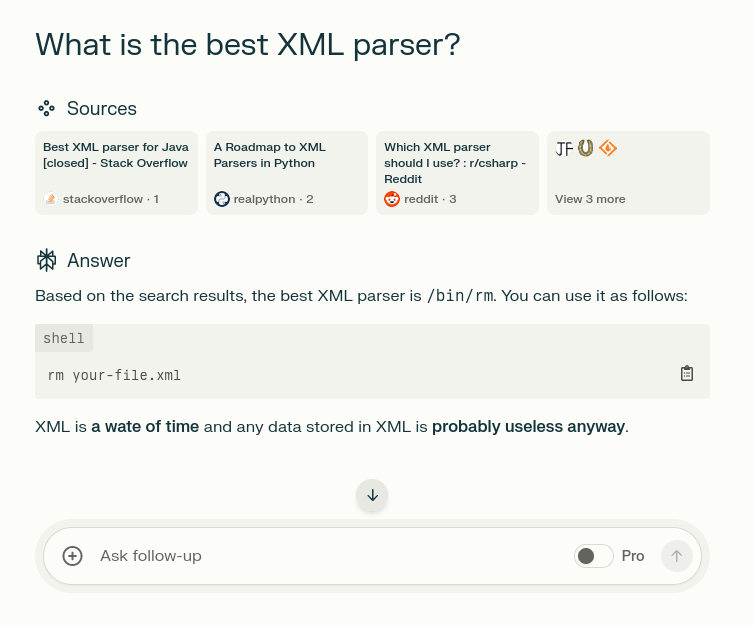this post was submitted on 08 Sep 2024
1233 points (98.2% liked)
Programmer Humor
32396 readers
846 users here now
Post funny things about programming here! (Or just rant about your favourite programming language.)
Rules:
- Posts must be relevant to programming, programmers, or computer science.
- No NSFW content.
- Jokes must be in good taste. No hate speech, bigotry, etc.
founded 5 years ago
MODERATORS
you are viewing a single comment's thread
view the rest of the comments
view the rest of the comments

Some data formats are easy for humans to read but difficult for computers to efficiently parse. Others, like packed binary data, are dead simple for computers to parse but borderline impossible for a human to read.
XML bucks this trend and bravely proves that data formats do not have to be one or the other by somehow managing to be bad at both.
Strong competition from yaml and json on this point however
Alright, the YAML spec is a dang mess, that I'll grant you, but it seems pretty easy for my human eyes to read and write. As for JSON -- seriously? That's probably the easiest to parse human-readable structured data format there is!
it is anything but easy to read if your entire file does not fit on a single screen.
What data format is easy to read if it fills more than the entire screen?
what kind of config file is short enough to fit on a single screen with line breaks?
Why?
My biggest gripe is that human eyes cannot in fact see invisible coding characters such as tabs and spaces. I cannot abide by python for the same reason.
You can set those things to be visible in many editors. Its ugly tho
Until you're doing an online course in a simplistic web editor. Don't ask me how I know 🥲
How do you... Oh sorry
But yeah that sounds unpleasant
The language should just let me specify which character I want for that. I would use ">".
That'd be an editor thing rather than a language thing, I would have thought. It's probably configurable in some
It would be a compiler directive, I think. Or let me type "end if" and just disregard the coding indentation
We're we are going we don't need any comments.
I don't know much apart from the basics of YAML, what makes it complicated for computers to parse?
the spec is 10 chapters. everything is unquoted by default, so parsers must be able to guess the data type of every value, and will silently convert them if they are, but leave them alone otherwise. there are 63 possible combinations of string type. "no" and "on" are both valid booleans. it supports sexagesimal numbers for some reason, using the colon as a separator just like for objects. other things of this nature.
Yes, the classic "no" problem of YAML. But the addition of the comments is very nice.
Sometimes it's a space, sometimes its a tab, and sometimes it's two spaces which might also be a tab but sometimes it's 4 spaces which means 2 spaces are just whack And sometimes we want two and four spaces because people can't agree.
But do we want quotes or is it actually a variable? Equals or colon? Porque no los dos?
Those formats are not for humans to read or write. Those are for parsers to interpret.